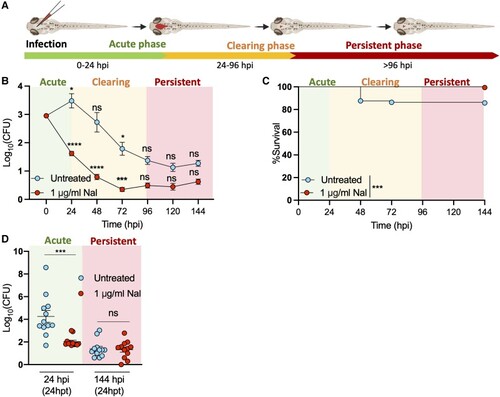
Shigella establishes persistent infection in zebrafish. A, Experimental diagram of S. sonnei–zebrafish infection. S. sonnei infection undergoes 3 phases: an acute phase (ie, increasing bacterial load), a clearing phase (ie, a steady decrease of bacterial load), and a persistent phase (ie, bacterial load does not further decrease). Diagram created with BioRender.com. B and C, CFU count and survival analysis from zebrafish larvae infected with S. sonnei 53G. Larvae were treated with the antibiotic Nal or left untreated. S. sonnei establishes a persistent infection in zebrafish, even during treatment with a therapeutic antibiotic dose. From 96 hpi, the bacterial load in larvae remains constant over consecutive days. D, CFU count from zebrafish larvae treated with Nal or left untreated during the acute and persistent infection stages. During the acute infection stage (0–24 hpi), S. sonnei is sensitive to antibiotic treatment, while during the persistent infection stage (120–144 hpi), S. sonnei becomes insensitive to antibiotic treatment. Data were analyzed at 24 hours posttreatment. Data: mean ± SEM. Statistics: B, unpaired t test on log10-transformed data against the previous time point; C, log-rank Mantel-Cox test; D, 1-way analysis of variance with Sidak correction. ns, P ≥ .05. *P < .05. ***P < .001. CFU, colony-forming unit; hpi, hours postinfection; hpt, hours posttreatment; Nal, nalidixic acid; ns, nonsignificant.
|